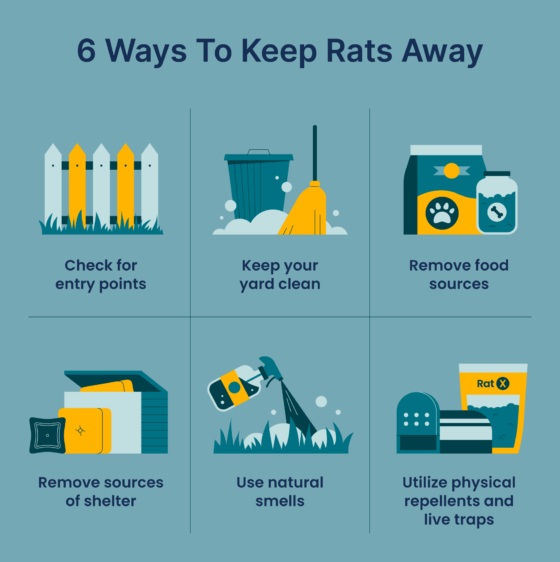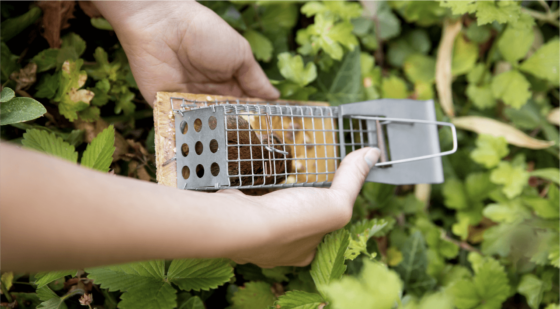How to Keep Rats Out Of Your Yard: 6 Natural Rat Repellent Techniques
Not only are rats unattractive to look at, they can also cause major destruction in and around your home. If you have a rat issue but do not want to use poison or other lethal measures to eradicate the population, you need a natural outdoor rat repellent. Or, to be more specific, you are going to need a combination of tactics to repel or prevent a backyard rat colony.
In this article
- Why use natural repellents?
- What are rats attracted to?
- Signs of an outdoor rat problem
- 6 ways to keep rats out of your yard
Why Use Natural Rat Repellents?
Killing rats off is, of course, the fastest and surest method for getting rid of outdoor rats, but there are several reasons you may not want to go this route.
- Killing rats means having a dead rat problem that you have to dispose of
- Lethal methods are dangerous for other animals such as birds or dogs
- Pesticides are outlawed in certain areas, such as California
What Are Rats Attracted To?
So, here’s the deal: rats are pretty simple (but rather smart) creatures that mostly want food, water and shelter. If they are hanging out in your backyard, that is because you are unwittingly providing them with these basic needs:
- Plants
- Smells and odors
- Overgrown plants
- Water sources
- Food sources
In order to reclaim your outdoor living areas, you need to encourage your current rodent residents to move on to more hospital accommodations and to discourage new rats and mice from making themselves at home in your yard.
Signs You Have Rats in Your Yard
You may not know you have a rat problem until you actually see one in your yard. But the fact of the matter is, rats are great at hiding. And they won’t hesitate to cause destruction to your property and belongings if the environment is right. A few signs that you may already have rats in your yard are:
- Droppings of ½ inch or larger
- Urine odor in and around the yard
- Gnaw marks on wood or outdoor materials
- Nests in the ground or within deep vegetation and clutter
- Garbage or clutter in unused areas
- Noises, especially at night, such as scratching or gnawing
6 Natural Ways To Keep Rats Out Of Your Yard

1. Check that your rat problem hasn’t moved indoors

The first step is to make sure that your outdoor rat problem has not become an indoor rat problem. To do this, you will need to inspect your house, garage, guest house and any other structures on your property. Look for evidence of rats, such as droppings or items that look like they have been chewed or scratched. If you find evidence of rats, you will need to simultaneously work on clearing your rat population both inside and outside of your house. Some of the methods below can be used indoors. You might also consider non-lethal, indoor pest repellent methods, such as ultrasonic rodent repellers that plug into regular electrical outlets.
Once you are fairly confident that your mouse or rat population has not moved indoors, you’ll then want to make sure that it is time to make sure they do not move inside when you begin to evict them from your yard. One of the most important things to do in this step is to fortify your structures to make them as rat-proof as possible. Look for potential entry points, which could be under doors, through windows, through crawl space entrances, through an attic fan, or even through cracks and holes that can be as small as a nickel (for mice) or a quarter (for rats). For each entry point, apply the following enclosure methods:
- Weather stripping
- Door seals
- Steel wool
- Cedar planks
- ⅛-inch hardware cloth or spray foam
Remember – you will need to do this for your house, garage and guest house, at minimum, but should also consider doing it for playhouses, garden sheds and other outbuildings.
Always make sure that there are no rats currently in the spaces that you are sealing off.
2. Clean up your yard

The next step in removing rats from your backyard is to give your yard a good cleaning. This includes removing any trash and getting rid of any type of clutter, which can provide them with shelter, places to hide and trails to get around your yard undetected.
An item you’ll want to consider moving is your wood pile. Even a small wood pile is the perfect nesting place for rats, so be sure to store it at least 18 to 24 inches off the ground and a few feet from any other structures.
The next step is to remove anything from the exterior of your home.This includes deck boxes, storage cabinets, doghouses and planters. Anything that could provide shelter or a trail system for rats to get around your yard needs to be relocated. It is best to keep bushes, shrubs and larger plants away from your walls as well.
If you do have trees and shrubs near your home, be sure to keep them pruned and trimmed at least a few feet away from your home.
A great preventative measure is to keep your grass trimmed and any unneeded clutter off your lawn.
3. Eliminate possible food sources

Animal feedback, backyard compost, gardens, pet waste and standing water are all potential food and nutrient sources for rats. Securing them, moving them away from your home or removing them from the yard are all ways you can deter rats. Let’s take a look at what to do for each specific food source:
Remove or securely store animal feed. All animal feed, including dog food, cat food, bird food, rabbit food, chicken feed and any other type of animal food you have in your yard needs to be stored in a completely sealed container. It is best to move this food out of the area completely while you work on reducing your rat population, but if it must be in your backyard, make sure it is in a rat-proof container and that you keep the container closed at all times.
This includes picking up any food bowls For outdoor animals, such as rabbits, chickens and other birds, keep rats out of your coup or aviary by lining the bottom section of the fence or walls with 1/8-inch hardware cloth.
Secure your compost. If you compost, purchase an above-ground compost bin that rats cannot get to and cannot enter. Keep it closed at all times and make sure it is set away from trees, fences or structures that could provide rats with access to it.
If you prefer to keep your compost bin on the ground, purchase a bin with solid sides and keep the lid securely in place at all times. You will need to install tight, thick, wire mesh beneath your bin to help keep rats out.
Place vegetable gardens away from your home. If you have a vegetable garden, move it as far away from your house and outdoor living areas as possible. As long as you have a vegetable garden offering foods they like to eat, rats may still be attracted to your yard. However, if it is tucked away in a back corner of your yard, at least that may help keep them away from areas where your children play or where you spend time with your family or guests.
Pick up pet waste regularly. While we are on the topic of pets, it is time to talk about pet poop. As gross as it may sound, rats love to eat dog poop, cat poop and just about any other type of poop.
Remove any convenient water sources. This could be pet’s water bowls, buckets of water, standing water and even ponds. It also means fixing any leaking pipes, faucets or garden hoses. However, while some water sources are easy to remove, others are not. For example, rats may chew through drip irrigation lines to get to the water inside. So, even if you have removed all of the standing water from the area, this does not necessarily mean that you can remove all water sources.
4. Eliminate sources of shelter

Plants, ground covers, barbecues and outdoor kitchens, patio furniture, and other outdoor structures like decks and gazebos are all prime sources of shelter for rats. Here’s how to keep rats out of each.
Move and secure garbage bins. If you keep your garbage bins in or near your backyard, make sure the lids securely fasten so that rats cannot use them as a hunting ground for food. If your trash cans cannot be properly sealed at all times, it is time to purchase new ones that can. Rats love trash cans. It is also important to keep the area around your trash cans free of trash, food scraps and spills that might attract rodents to your yard.
Get rid of ivy and other ground covers. Ivy running along your fence might look lovely in your yard, but it is also providing a freeway for your rats to roam around safely and without detection. While ivy is definitely a culprit in many backyard rat infestations, it can happen with any ground cover, bushes or shrubs that provide decent coverage (with some exceptions that rats do not like, such as lavender). No matter how much you love your ivy, it is time to rip it all out if you want to get rid of your rat problem.
Secure your barbecue grills and outdoor kitchen. Secure your barbeque grill by making sure it’s securely closed when not in use, particularly if you do not use it often. Also make sure that under-grill storage areas, cabinets in your outdoor kitchen can be securely closed and not opened by a rat. Be sure to keep your outdoor kitchen areas clean and free from food at all times.
Keep your patio cushions in a secure cabinet, closet, shed or deck box when not in use. If you already have backyard rats, then you likely have seen the evidence that they love to nap on cushy surfaces just as much as we do. Also keep in mind that covering your patio furniture is a great way to protect it from the elements, but it also creates convenient shelter for backyard rats and mice. Your safest bet is to keep patio cushions in a secure place, especially if you already have a rat problem.
Block open passages beneath decks, gazebos and other outdoor structures. Wood decks, gazebos, garden sheds, ornamental bridges, doghouses and other non-moving structures are some of the most popular places for rats to make a home.
If possible, move gazebos and sheds away from other structures so that there are several feet of open space on all sides. Next, you need to block entry to areas beneath your deck or other structures in your yard that could provide shelter to rats. You need to completely block access, because even the narrowest spaces can allow entry. Rats do not like the smell of cedar, so you might consider using cedar to block the perimeter of your deck, shed or gazebo.Use rocks or even better, mortar to fill any openings to block rat entry.
Rat infestations can be a particular problem with wood decks that are close to the ground. While it is probably a bit extreme to rip out your deck to try to get rid of your rats, it is worth considering replacing it with something like a paving stone patio once it is time to replace it anyways.
5. Use scents as a natural rat repellent
Rats rely on their sense of smell for finding food, avoiding predators and other tasks essential to their survival. Because of this, rats do not usually like to hang around in areas where there are fragrances that mess with their ability to seek out food or know if a cat is around. Below are a few ways to use scents to deter rats:
Plant lavender and mint in your garden. Lavender and mint are two examples of plants that rats generally try to avoid, so it may be helpful to plant lavender or mint in areas where rats frequent, around decks and other structures that may provide shelter, or around the perimeter of your yard. You can also scatter fresh or dried lavender and mint around your yard, but this will require regular replenishing.
Place scented dryer sheets around your yard. Scented dryer sheets interfere with a rat’s ability to smell the things he or she needs to smell in order to survive. Stuff dryer sheets under your deck, behind dog houses or in other areas where you have seen rats, it may help deter them from hanging around your outdoor living areas.
Place peppermint oil and/or eucalyptus oil in suspected nest locations such as under decks, being dog houses, and in your vegetable garden beds. Simply combine peppermint or eucalyptus oil with water and spray around potential nesting areas such as under and around decks, dog houses and in your vegetable garden. Another effective way to use these oils is to soak rags or cotton balls in the oil and place them around your yard.
A note for pet-owners: If you choose to use dryer sheets, rags or cotton balls to distribute the scent, make sure that your dog is not going to eat them. Animals metabolize essential oils differently than humans and it can be harmful to their health.
Whether you spray or use cotton balls, you will need to replenish your repellent after it rains or if you irrigate the area.
Use pet urine as a natural outdoor rat repellent. Options include letting your dog urinate all over your yard, scooping out the urine-soaked cat litter from your cat box and placing it in areas where you think rats are living, or purchasing one of many types of predator urine, including mountain lion, bobcat or coyote urine.
All of these options are going to smell exactly like you think they are going to smell, so you may want to consider that before using them in outdoor living areas.
6. Use physical rat repellents + live traps

Spread pellet rat repellents throughout your yard. These are all-natural, non-toxic repellents that work to repel rats with the smell of predator urine.
Pro Tip: Ensure that you are purchasing an all-natural, non-toxic pellet repellent and not some type of poison. The containers can look almost identical, so make sure you thoroughly read the label or research the product before using it. It should clearly state on the label that it is safe for use in areas frequented by pets or children.
Pellet repellents usually either smell like predator urine or contain some of the natural oils that rats do not like, such as peppermint or eucalyptus oils. In most cases, you will need to regularly replenish your pellets, particularly after rain or irrigation.
Set out pouch rat repellents. Mouse and rat deterrent pouches are usually made with oils or plants, such as those mentioned above, that naturally deter rodents. Since this works on the same scent-based repellent idea, pouches are mostly just an easier, cleaner way to spread the scent. Pouch repellents are typically most effective indoors, but you may find success in using them in smaller outbuildings or under decks and gazebos.
Install an outdoor electronic rat repeller. Ultrasonic pest repellents that can be plugged into regular electrical outlets are most commonly used indoors, but there are some models that are designed for outdoor use. Some of these outdoor models even have flashing lights and other sounds to help scare away pests. Most of them have settings to allow you to ward off only unwanted animals, but it should be noted that almost all outdoor ultrasonic repellers are designed to ward off all animals, including dogs, cats, deer, raccoons, rabbits and squirrels. Therefore, if you have pets or welcome other types of wildlife in your backyard, this might not be the right choice for you.
Employ live traps. Live trapping involves catching your rats in a non-lethal trap, and then taking them somewhere to release them. This is a popular method for removing unwanted animals without killing them, but it is a bit more complicated than it may first appear. To avoid killing the rats, you’ll need to check the live trap multiple times a day and be prepared to take the full trap to a far away release location.
Note: Live traps must be checked multiple times each day to avoid rats dying from dehydration or starvation. You must also be ready to take full traps to the chosen release location to keep them from dying in the trap.
Dry ice is another great natural rat deterrent. Dry ice releases carbon dioxide which acts as a natural anesthetic for rats. Carefully place dry ice to entry points and/or potential nesting spots to keep rats away.
Frequently Asked Questions
How can I get rid of rats inside my home?
If you suspect you have a rat problem indoors, the first thing you’ll want to do is inspect potential entry points. Next, seal these entry points both inside and outside the home with things like caulk, mortar, cement, wire mesh, etc. Once you’ve sealed any potential entry points, be sure to clean up and remove any potential shelter and food sources to avoid attracting rats. Natural deterrents such as peppermint and eucalyptus can be used indoors and outdoors to keep rats away.
How can I get rid of rats overnight?
A safe, quick way to get rid of rats quickly is to use catch-and-release live traps. But be wary of the fact that if you do have a rat problem, there’s likely more than one hanging around your yard. Consider combining multiple natural rat repellent methods listed in this article to get the job done safely and quickly.
How fast do rats reproduce?
Female rats can produce up to 2,000 off-spring in one year. They can also mate up to 500 times per day. So it’s best to use preventative measures when dealing with a rat problem.
What diseases do rats carry?
Rats are known to carry a wide array of diseases such as Hantavirus, Lymphocytic Choriomeningitis virus, Salmonella, Rate bit fever, Tularemia, and most recently, Hepatitis E.
